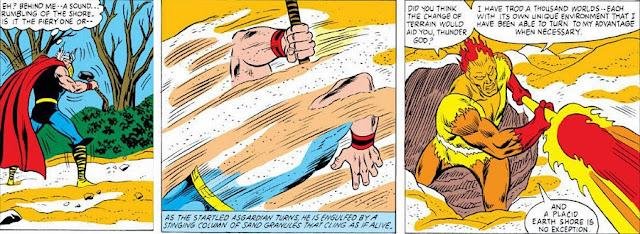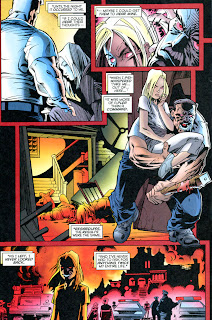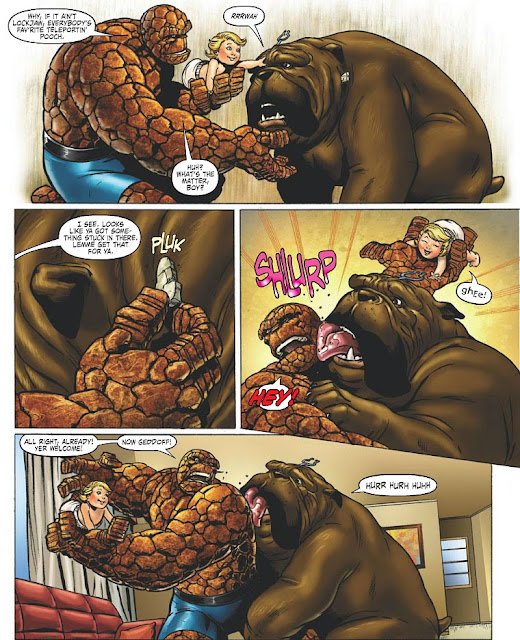After the battle where Thor finally ended the threat of the Air-Walker, young Kevin Matheson wasn't feeling too inclined to send any Christmas spirit in the God of Thunder's direction:
Nor does it seem the newly arrived Firelord is bringing any tidings of great joy:
Good grief! Why is Thor being dumped on this time of year??
Like Kevin, Firelord seems to be operating under the misconception that Thor has slain an innocent being. But the similarities end there, since Firelord has the power to incinerate Thor for his alleged crime:
...or does he?
Yeah, about that--let's settle the matter once and for all that FIRE PRESENTS NO DANGER TO THOR. Doesn't that seem ridiculous? I can't believe no one has ever said it out loud like that. But look at all the times he's brushed off Firelord's attacks. Look at how many times he's battled Surtur and survived. The guy can even leap into an open-pit furnace--a furnace, mind you--and carry on a conversation with himself as if he's running down his things-to-do list for the day:
As for Firelord, he's even attacking Thor with cosmic-powered flame, "birthed in the raging heart of a million suns." Phooey. Apparently he could drop one of those suns on Thor and not even be able to give him a tan:
Jeez, look at this guy. Not even his clothing caught fire? Or his hair? Really? Hold a strand of hair over the flame of a match and see what happens. I guess even Firelord has a thing or two to learn from we humans.
But Firelord isn't through with Thor yet, not by a longshot. And their fight takes them into the water:
As well as the beach:
Before Thor has finally had enough and unloads on this hothead:
With things between Thor and Firelord at such a fever pitch, you'd think the last thing Thor would think of would be surrendering to him in order to end the fight--particularly with Firelord so focused on revenge. Of course, he's probably thinking, "What can it hurt to try? After all, it's not like this guy's stupid fire can harm me." But the tactic works, particularly when Thor knows there's the extenuating circumstance of Firelord's grief over Gabriel still hanging in the air:
And so Firelord recounts for Thor his history with Gabriel--as fellow Xandarians, who had an unfortunate encounter with the ship of none other than Galactus:
But Gabriel's successful and now willing association with Galactus was fated to come to an end, as well as a new beginning:
The "new" Gabriel, unfortunately, was no substitute for the more engaged herald Galactus had come to know--and so Galactus set out to reclaim the Silver Surfer, still imprisoned on Earth, and again conscript him as his herald; but thanks in part to the mechanical Gabriel's arrogance, the encounter instead led to Galactus being driven from Earth empty-handed. Eventually, Pyreus--Gabriel's comrade on his old ship--locates Galactus and demands the return of his friend, though the meeting would take a different direction:
Now that Thor has all the facts, he's able to help to finally provide Firelord with the closure he's been seeking regarding his friend. And Firelord's departure from Earth has Thor reflecting favorably on the episode:
As for Firelord--with his memories now restored to him of the robot Gabriel's origin, I would have thought he would have sought out Galactus in order to locate his friend's body and mourn his loss, rather than funnel so much of his grief into a robot that held little if any of his comrade's disposition and only mirrored him physically. Indeed, it would have stood to reason that Firelord would already have come to terms with Gabriel's death, once Galactus kept his word to Pyreus and subsequently revealed Gabriel's fate to him after transforming him into Firelord. But it's a touching epilogue to the story, if a little after-the-fact.
By the way, on a more unpleasant note, the thought occurs that when Thor's time ever comes, he'll have to have burial rites as well, since cremation isn't likely to have any effect on him.
("Siegfried" doesn't count.)












































































































































































































































